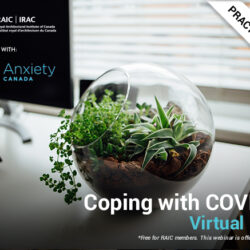This website uses cookies so that we can provide you with the best user experience possible. Cookie information is stored in your browser and performs functions such as recognising you when you return to our website and helping our team to understand which sections of the website you find most interesting and useful.
RAIC Catalyst For Change – Patrick Stewart
January 2022 To celebrate and honour RAIC volunteers, we are pleased to introduce you to Dr. Patrick Stewart, MRAIC, Architect AIBC, and Chair of the RAIC Indigenous Task Force and Co-Chair of the RAIC Truth and Reconciliation Task Force. Thank you, Patrick! Why did you decide to become an architect? I wanted to be an architect since I was five years old. I didn't know what architecture was at that time, but I loved buildings. I walked to buildings to look at them since they fascinated me because they looked so monumental.

January 2022
To celebrate and honour RAIC volunteers, we are pleased to introduce you to Dr. Patrick Stewart, MRAIC, Architect AIBC, and Chair of the RAIC Indigenous Task Force and Co-Chair of the RAIC Truth and Reconciliation Task Force.
Thank you, Patrick!
Why did you decide to become an architect?
I wanted to be an architect since I was five years old. I didn’t know what architecture was at that time, but I loved buildings. I walked to buildings to look at them since they fascinated me because they looked so monumental. There was a particular church in Victoria and as a five-year-old I loved looking at it. There was also a particular round church called the First Church of Christ that I used to walk to, as well as the Empress hotel downtown and the BC Hydro building and that was what I just loved to look at. As I grew older, I thought that would be something to try to get involved with. As I grew older, I knew you needed to go to school, but I didn’t like school, so it was an issue for me to pursue. However, I persevered and eventually got into architecture.
How long have you been an RAIC member and what do you see as the value of your membership?
I first became an RAIC member in the ‘90s but I didn’t maintain my membership because, at that time, I struggled to see what the value of the RAIC was. But since I became involved in 2015 with organizing the Indigenous Task Force, which I chair, I’ve maintained my membership. So, I have come to see that it does have value to members, and society in general, as an advocacy organization. Also, as an advocacy organization, it can influence change. So, it is a good rallying point for Indigenous youth who want to become architects and a place where people can meet.
Why do you volunteer for the RAIC?
I see the value that it provides to people in the profession, particularly to Indigenous students, interns, and members. For me, it attracts like-minded people. Moreover, there are not a lot of Indigenous architects, I think there are less than 20 in Canada and the same number of Indigenous architecture students, which is very few when you compare it to the national number of architects in the country.
What do you find most challenging about working as an architect?
I think there are so many things that are challenging, from obtaining commissions to getting jobs, and trying to maintain a certain level of excellence. It is also difficult to get staff who are like-minded.
Why is this area of advocacy important to you?
Architecture isn’t it a widely sought-after profession and I think a lot of it has to do with people not knowing what exactly an architect does or what architecture can do for communities. I think that it is that architecture provides value to society in general.
What do you think will most change/shape practice over the next five years?
I think the use of computer-aided software is giving us more tools–not only in terms of AutoCAD, but also other workflows, such as specification writing, project management, construction management, and all those tasks that can benefit from computerization. And that is changing our practice quite a bit. Especially in this time of the pandemic, we’re relying more and more on working remotely and making sure our staff have the tools to do so to be successful. So, it is evolving and who knows what other changes are going to bring. For example, with all the flooding in BC, my wife and I are now stranded in our hotel room, and, amazingly, I can still get work done as long as I have my laptop.
What role do you see the RAIC and architects playing in terms of climate action, truth and reconciliation, and procurement reform, among other issues that matter?
I think RAIC has an advocacy role to play in all of those issues, from procurement to climate change. One of the issues is that because everybody is busy and the RAIC is built on the backs of volunteers, I often question if this is the way to run an organization. Even the federal government relies a lot on volunteers. But again, there aren’t enough resources to have people compensated for participation, so volunteerism is one of the mainstays of the RAIC, and I think that the RAIC has a role and, just recently, that it has started to think internationally. In my opinion, that’s a very good effort especially for Indigenous communities because we have the United Nations Declaration on the Rights of Indigenous Peoples as an international instrument. I think we could have a very important role to playn and I think RAIC is very serious about reconciliation and wanting to show support and leadership to the Indigenous peoples.
What do you like to do outside of architecture?
I like to read, I like collecting books, I like writing. I’m always working on things, and I always have a book project going. For example, we had published a book in 2018 called Our Voices: Indigeneity and Architecture and then in 2021, we published Our Voices II: The De-Colonial Project, and then we have a third book coming out next year on the catalyst for change, looking to the future, what changes are coming, and what architects can do to work with Indigenous communities.
What advice would you have for those looking to get more involved in advocacy causes related to architecture?
I would say get involved and reach out because there are a lot of opportunities.
Recommended Reading
Recommended Products



